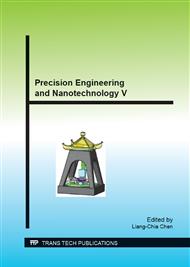p.355
p.360
p.366
p.372
p.378
p.384
p.392
p.398
p.402
Identification of Flow Stress Applicable for FEM Simulation of Orthogonal Cutting Process
Abstract:
Nowadays, numerical simulation technique is very popular to estimate and predict the machining parameters such as cutting forces, stresses distribution, temperature and tool wear. The objective of this study is to determine the 0.45%C steel (JIS S45C) flow stress value under high strain rate and temperature. The Johnson and Cook (JC) material model is used as a constitutive equation to describe the high speed cutting process. Compression test and orthogonal cutting test were carried out in order to obtain the required parameters in JC model. Inverse calculation method was used to determine the strain rate and temperature dependency parameter based on several cutting conditions. As a result, validity of verification of method was completed and the flow stress of S45C had been evaluated.
Info:
Periodical:
Pages:
378-383
Citation:
Online since:
August 2014
Authors:
Keywords:
Price:
Сopyright:
© 2015 Trans Tech Publications Ltd. All Rights Reserved
Share:
Citation:


